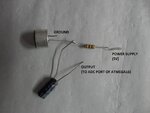Arnab Ray
Newbie level 6
Hi everyone,
I am trying to connect an electret microphone to the ADC port (port A) of Atmel Atmega16. My aim is to light an LED when there is a sound.
I have directly connected the mic to the input port of the micro controller. But there is no voltage detection at the input, even after changing the potentionmeter value.
Please advice me how i should connect the mic to the micro controller. Also please tell the IC number of any pre-amplifier, if required...
The image of the connection made by me is shown below:

I am trying to connect an electret microphone to the ADC port (port A) of Atmel Atmega16. My aim is to light an LED when there is a sound.
I have directly connected the mic to the input port of the micro controller. But there is no voltage detection at the input, even after changing the potentionmeter value.
Please advice me how i should connect the mic to the micro controller. Also please tell the IC number of any pre-amplifier, if required...
The image of the connection made by me is shown below:
